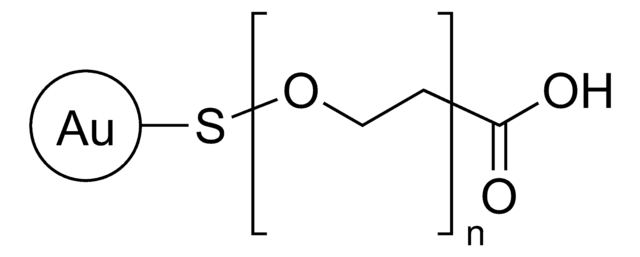765325
Gold nanoparticles
15 nm diameter, amine functionalized, PEG 5000 coated, OD 50, dispersion in H2O
Synonyme(s) :
Gold nanoparticles NH2 functionalized, Au NP NH2, Gold Colloid
About This Item
Produits recommandés
Matériaux
PEG 5000
Forme
dispersion in H2O
nanoparticles
Conditionnement
poly bottle of 1 mL
DO
50
Diamètre
15 nm
pH
6.0-8.0 (25 °C)
Solubilité
water: miscible
Densité
1.00 g/cm3
λmax
520 nm
Groupe fonctionnel
amine
Température de stockage
2-8°C
Vous recherchez des produits similaires ? Visite Guide de comparaison des produits
Description générale
Application
Caractéristiques et avantages
- A negatively charged siRNA-PEG complex, attached to positively charged GNPs, is easily cleavable in reductive cytosolic environment thus enabling the release of siRNA into cytosol.
- The PEG coating, decreases the cytotoxicity and increases efficiency of GNPs. PEG increases the stability of the nanoparticles and prevents agglomeration.
Code de la classe de stockage
10 - Combustible liquids
Classe de danger pour l'eau (WGK)
WGK 2
Point d'éclair (°F)
Not applicable
Point d'éclair (°C)
Not applicable
Faites votre choix parmi les versions les plus récentes :
Certificats d'analyse (COA)
Vous ne trouvez pas la bonne version ?
Si vous avez besoin d'une version particulière, vous pouvez rechercher un certificat spécifique par le numéro de lot.
Déjà en possession de ce produit ?
Retrouvez la documentation relative aux produits que vous avez récemment achetés dans la Bibliothèque de documents.
Articles
The recent emergence of a number of highly functional nanomaterials has enabled new approaches to the understanding, diagnosis, and treatment of cancer.
Biomaterials science involves the design and fabrication of smart materials for studying, directing, or mimicking biology. For successful integration of biomaterials in biological research, a meaningful understanding of biological systems is required.
Notre équipe de scientifiques dispose d'une expérience dans tous les secteurs de la recherche, notamment en sciences de la vie, science des matériaux, synthèse chimique, chromatographie, analyse et dans de nombreux autres domaines..
Contacter notre Service technique


